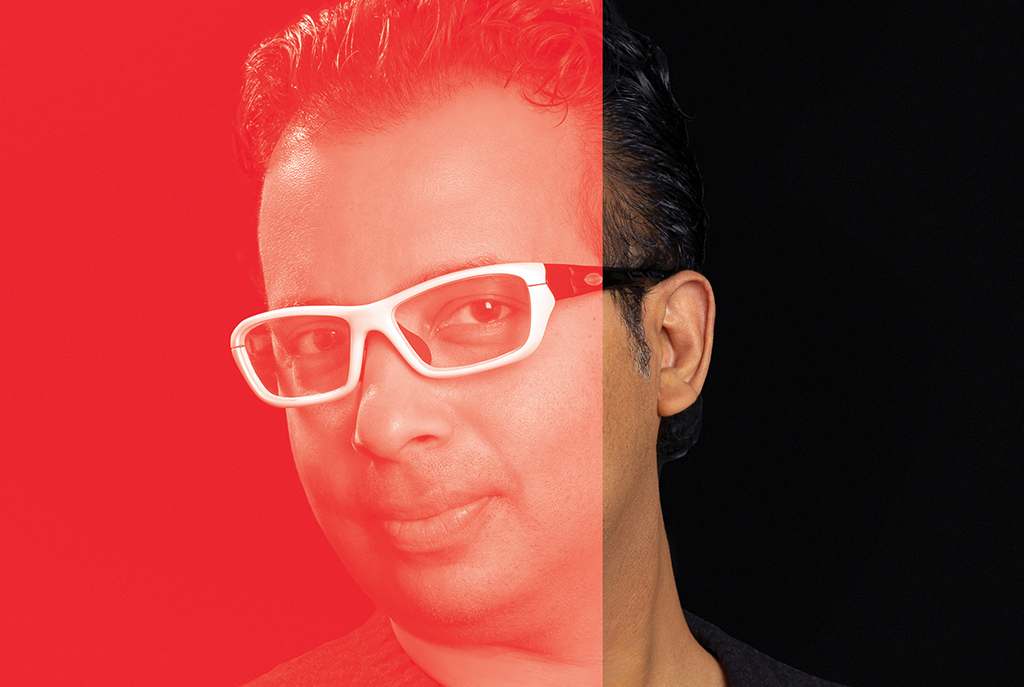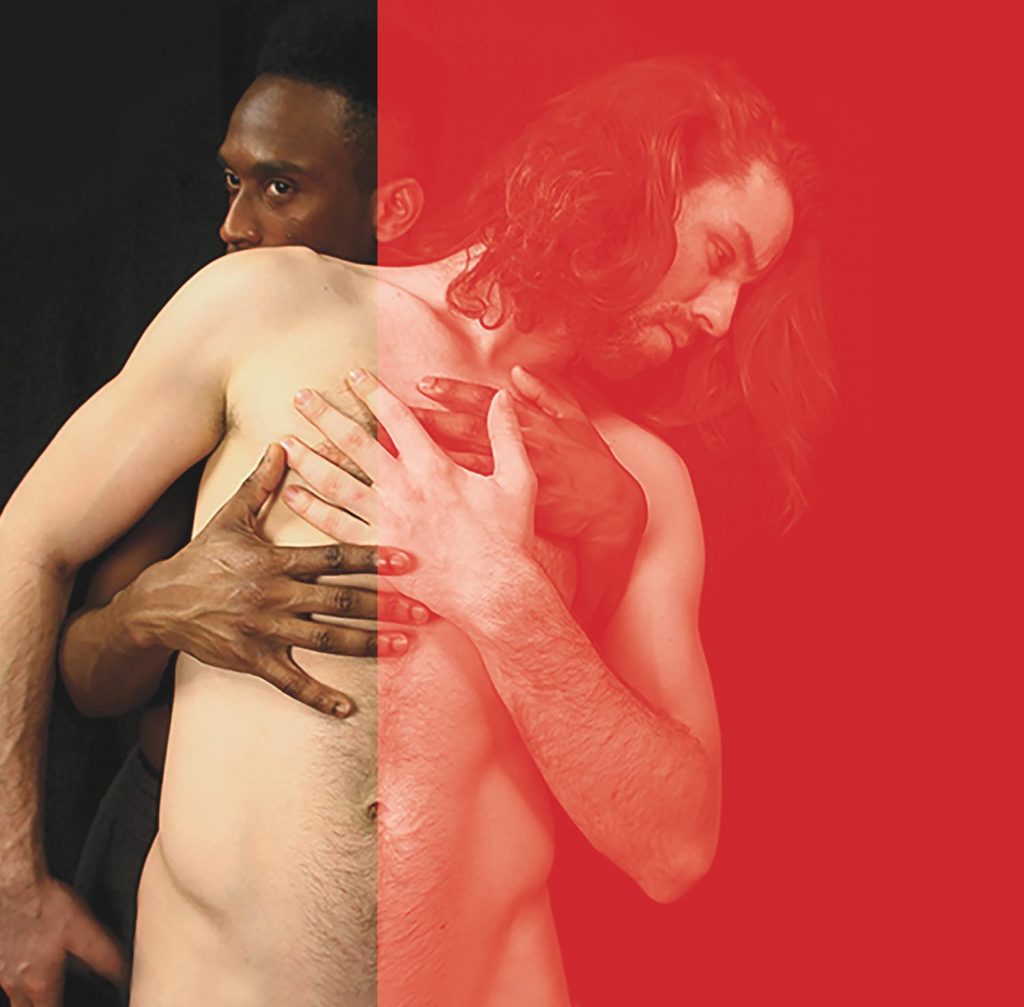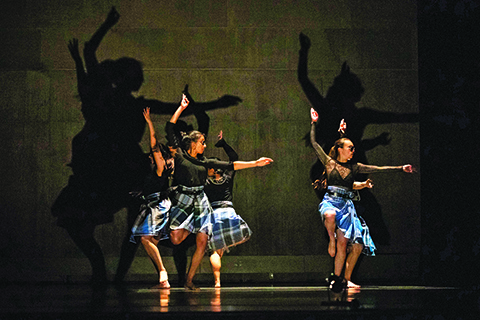The Politics of Dance

Professor Hari Krishnan examines and reclaims the original power of Bharatanatyam, the hereditary courtesan dance from South India, by reimagining it in the context of contemporary culture and a liberal arts university, based on decades of rigorous study, research, and practice.
Hari Krishnan’s work is defined by contrasts. His parents posed a vital one for his creative process at an early age: his father, an Indian classical actor/dancer, stressing the importance of lightheartedness; his mother, a Singaporean musician and teacher, telling him to be serious in his pursuits.
“My father said to really live life to the fullest,” Krishnan recalls. “Don’t take life too seriously; don’t take yourself too seriously. Because, at the end of the day, we’re just going back to ashes. My mother said to approach everything with an uncompromising work ethic. There are no shortcuts to life. It’s hard work all the way.”
While this advice may seem confusing or contradictory, Krishnan has found that dance allows him to move fluidly in the space between these two poles. His creative flexibility comes from both his strong work ethic and his vibrant sense of humor. It extends to the many contrasts that characterize his personal history—growing up in Singapore; pursuing a serious study of courtesan dance in India; earning his bachelor’s in Canada studying linguistics and his doctorate in Texas studying dance; now teaching Bharatanatyam—historically a courtesan dance passed along through hereditary lineage—at a progressive liberal arts college in the United States, while also choreographing for his dance company, inDANCE, in Canada. Through his art, Krishnan both earns his living and uses it to push back against cultural, racial, ethnic, and sexuality bias.
Showing Skin
Nowhere are these tensions and opportunities more evident than in the blend and flow of his choreographic work, SKIN, which debuted in Middletown last April for the Spring Faculty Dance Concert at Wesleyan’s Center for the Arts. The five dances of SKIN, performed by his Toronto-based company inDANCE, as well as six Wesleyan undergrads and an alumnus, included the provocatively named “Mea Culpa” and “Holy Cow(s)!,” along with “Boxes 3, 7 & 8.” All were personal for Krishnan.
“These are the issues I’m facing: gender identity, sexuality, cultural appropriation, racism, homophobia, and looking at a critical dance history in new ways,” he says. “I engage with these issues through full disclosure. ‘Holy Cow(s)!’ began with some statements, like ‘Hari, you are Indian, which means you do not eat beef.’ I love my Big Macs. So, I break that stereotype, that paradigm of the ‘sacred’ cow. Rupturing cliché/stereotype is significant in my choreography.”
Toronto Star dance critic Michael Crabb calls Krishnan’s work, “consistently exuberant, physically dynamic and often more than a little bit naughty.” Additionally, the Star refers to Krishnan’s penchant for inserting political messages in this art form, calling him a “maverick gadfly” and “aggressively iconoclastic . . . (who) scoff(s) at tradition, turn(s) things upside down and shake(s) out all the cobwebs.”
In “Mea Culpa” (“I am Guilty”), an Indian bridegroom, danced by Spenser Stroud ’22, decides he can’t go through with his arranged marriage. Shedding traditional wedding garb for fishnet stockings, he breaks out into seductively ebullient yet stylized movements that recall Jacob’s Pillow-founder Ted Shawn’s appropriation of Indian dance in his 1926 solo The Cosmic Dance of Shiva.
Krishnan is playing with levels of appropriation. A scholar as well as a dancemaster, he grounds his work in reimagining Bharatanatyam by placing it within the cultural context of the form’s appropriation that began in 20th-century India.
He explains this history and its political implications: “As the nation of India became independent, those in power took Bharatanatyam out of its indigenous community of hereditary courtesan performers and placed it within a new middle class of nonhereditary dancers.” The new power elite purposefully twisted the meaning and aesthetic representations of courtesan dance.
“Bharatanatyam, once the expression of the erotic nature of human love, was recast as a performance about overt, reimagined mythology, religion, and orientalist spirituality in this newly invented Indian nation. The courtesan dancers, formerly a class of venerated artists, were disrespected and marginalized. The reinvented ‘classical dance traditions’ of India are embodied performances of somatic cultural nationalism.
“The question of what to do with this problematic received-history in an age of rising Hindu nationalism raises serious, existential questions about the idea of dance as ‘tradition’ or ‘heritage.’”
Adapting Tradition
Despite the Star’s assessment, it is not quite true that Krishnan is scoffing at tradition in the dances he creates. It is more accurate to say that he is updating it and making it his own. His art reflects life’s ebb and flow, including a childhood filled with dance and then a purposeful move away from it.
“I knew I wanted to become a dancer,” he recalls of his youthful plan to enter the University of Manitoba as a first-year student. “But my mom was freaking out with the angst of ‘Can you make a living from art?’ She made me promise I would major in something else.”
An introductory course in the study of the structure of language—including morphology, syntax, phonetics, and semantics—provided unexpected insight.
“Linguistics gave me an outsider’s view, a way of looking at dance through its building blocks,” Krishnan says. Rather than syntax and parts of speech, a choreographer works with bodies, time, space, and energy to convey meaning through his creation.

Krishnan returned to dance for his advanced degrees: a master’s at York University followed by a doctorate at Texas Women’s University, the academic credentials that brought him to Wesleyan in 2001. At the time, Wesleyan Dance Chair Pedro Alejandro was expanding the breadth of the department.
“Pedro envisioned a new generation of dance educators who were immersed in their respective dance form, but also used it to speak in a global language,” says Krishnan.
Wesleyan further appealed to him because of the Bharatanatyam legacy already established in the 1960s, when the University had welcomed one of the finest dancers in this tradition, T. Balasaraswati, who taught for several semesters on campus. Her brothers, musicians T. Ranganathan and T. Viswanathan, also joined her in Middletown and made the ethnomusicology department at Wesleyan their academic home.
“I feel humbled and grateful to be part of a progressive Dance Department that has nurtured me as both an educator and an artist. My brilliant colleagues at the Dance Department continue to inspire and motivate me,” Krishnan says.
Class in Session
Each fall, Krishnan teaches Beginning (and Intermediate/Advanced) Bharatanatyam in the Cross Street Studio. His students will serve as “ambassadors of the form” in time for the Worlds of Dance concert in December.
As class members enter the studio, they are likely to hear Krishnan before seeing him. His laughter drifts up the staircase from the offices below, entering the spacious room as a warm sound, rich in enjoyment, deeply imbued with presence. New students might think sheer joy—his father’s ethos—will dominate the class. However, they’ll find meticulous work—his mother’s admonition—will weigh equally in the creative process. One of Krishnan’s favorite T-shirts bears out this tension in a quote by Chinese artist and dissident Ai Weiwei: “Everything is art. Everything is politics.”
Along with that: “Generosity, kindness, compassion, and mutual respect: Without that, I cannot teach,” Krishnan says, defining the overarching guidelines of his class. “We are part of this democratic playground, where we engage and we inspire each other; we nurture and we lift each other up.”
Those are the starting points for Krishnan’s Bharatanatyam students, who arrive from a range and variety of dance backgrounds, yet will perform on stage only a few months later.
But first: “I need to assess the students, before I can make a piece that will be meaningful for them,” Krishnan says. His choreography, as well as the music (sometimes with original compositions by Adjunct Associate Professor of Music B. Balasubrahmaniyan), will be geared to their capabilities. What he sees this year delights him: “Open minds, open bodies, a vibrancy.”
As with teaching a new language, Krishnan starts with small bits of information and builds toward longer phrases, which he is apt to rearrange, inviting the dancers to be comfortable with change while he navigates a fine line: pushing kinesthetic rigor without overwhelming them.

During class, no part of a dancing body misses his scrutiny. And even as he is paying close attention to each student’s movements, he is also thinking about how the dance will coalesce as a whole. A dance performance, after all, is about bringing movements into carefully crafted harmony and tension with each other, which Krishnan calls “ensemble magic.” Even so, meticulousness is not to be confused with the pursuit of perfection.
“Perfection is a word that irritates me,” Krishnan says. “We are not perfect people. My formations, my group patterning is all asymmetrical. These are some of my creative interventions in how I choose to redefine this classical form in the context of a complicated world we currently inhabit.”
Dance as Protest
What is complicated? “The current political climate in various parts of the world is dictated by extreme fundamentalist policies, unfortunately, which inevitably affects the arts too,” Krishnan explains. “And dance and music are front-and-center in those politics.
“I see my class as a protest: I’m very particular that the composition must be secular
and that the students—in addition to learning aesthetic representations—are made aware of the critical social history of Bharatanatyam. The kinesthetics of the form will reframe received narratives about its past, looking to the dancing body as a malleable, porous site for the embodiment of social, historical, and political discourses. The dance has to be about more complex ways of looking at gender, queerness, identity, and nationhood. I’m not talking ‘queer’ in terms of LGBTQ+. I’m talking about queer in terms of a wider circulation of accessibility and outreach—‘everybody can love anybody.’”
This fall, Krishnan’s classes were progressing smoothly, allowing him to integrate these important influences into his work. Then came news that his father in Singapore was gravely ill; it would be best if Krishnan came to visit soon. While this could have been disastrous for the performance, Krishnan had finished his choreographic work ahead of time, enabling him to depart to see his father, without leaving the class adrift.
The one aspect of the upcoming dance concert that would be affected by his trip?
“Usually the class wears colorful saris,” Krishnan says. “But I had to make a choice. Do I want it to be a costume show, but a lackluster performance because there was no time for them to understand the choreographic arc? Or do I want to use neutral costumes, but get an excellent movement experience out of this class? I chose the latter and the neutral costuming choice immediately created a contemporary accessibility, enabling audiences to experience the beauty and architecture of the dance.”
For the performance, the students wore black leggings, shirts, or leotards, and engaged with the audience through intricate, enticing movement formations. The understated costumes contrasted perfectly with the brilliance of the dance. As in his life, the balance of his mother’s hard work (displayed in the intricate, demanding choreography) and his father’s lighthearted approach (evident in the performance’s high energy) fused in a profound way.
Krishnan finds that this organic synthesis is unique to both his experience and to Wesleyan.
“At a conservatoire, there’s a yard stick. One need to constantly aspire to this arbitrary world of unfair/unhealthy notion of perfection,” Krishnan says. “But there is no perfect dancer. I am always interested in the physical and mental wellness of my students. Everybody lives/loves in different ways. All five fingers are different. How can you expect each dancer to feel and perform a specific way? I teach them the framework of the choreography, but I always encourage them, ‘What you do to it is yours; it’s no longer mine. I’ve taught it to you. Now you make it yours.’”
For more on Professor Hari Krishnan and his work, please see “Art is Not Convenient” (our video interview with him), “Feeling the Dance, Thanking the Ground, Releasing the Diva” (comments from his Bharatanatyam students last fall), and “Dance as a Conduit to Self” (a profile o Eury German ’16, who performed in Skin).
